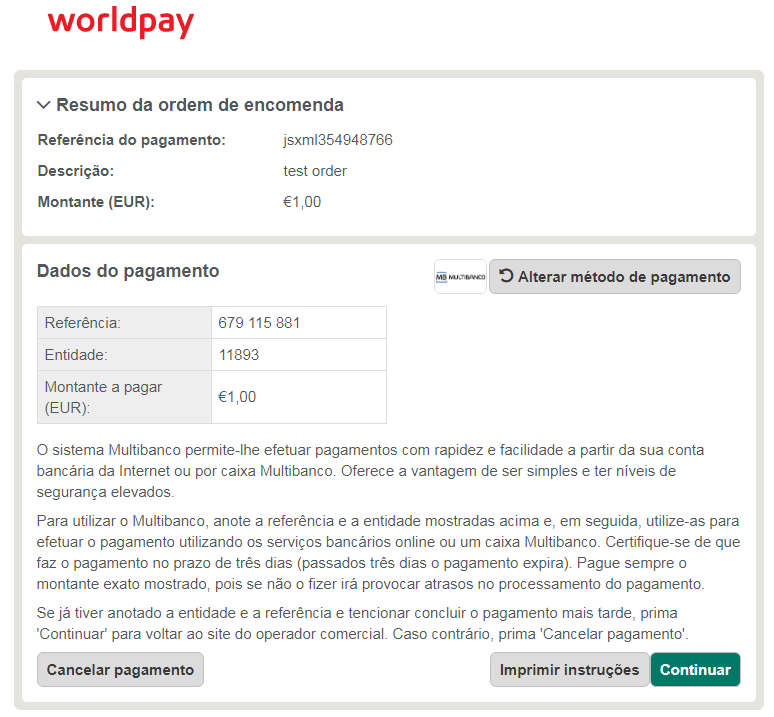Multibanco is an interbank network in Portugal. This network is run by SIBS (Sociedade Interbancária de Serviços S.A.) and enables many services, including payment services, to be hosted.
Make yourself familiar with our API Principles to ensure a resilient integration.
Product overview
Your customers can use Multibanco to pay through their internat banking or by using an ATM. The service is supported by all major banks in Portugal, and is therefore accessible to the maximum number of customers.
| Payment type | Country | Acceptance Currency | Recurring | Reversals | Partial Reversals |
|---|---|---|---|---|---|
| Post-pay voucher | Portugal | EUR | ❌ | ❌ | ❌ |
- Minimum Transaction Value: 1.00 EUR
- Maximum Transaction Value: 2.500 EUR
- On the payment method page, your customer selects the Multibanco payment method
- Your customer logs in to the Multibanco page. The page displays a payment reference and other details that your customer can use to complete the payment

- Your customer completes the payment, using the payment reference, in either their online banking app or using an ATM
Your customer must complete the payment by 23:59 UK time on the third day after the order was placed in the system. For example, if you submit a payment to our system at 15:29 (UK time) on Wednesday, your customer must use an ATM or bank to complete the payment by 23:59 (UK time) on Saturday. Wednesday + three days = Saturday.
Setting your headers is an important part of an API request. The headers represent the meta-data associated with your API request.
Authorization: {your_credentials}
Content-Type: application/json
WP-Api-Version: 2023-06-01| Header | Description |
|---|---|
Authorization | We use the Authorization header to identify and authenticate you within Access Worldpay. You -must- use the Authorization header for any request you send to our APM API. |
Content-Type | We require the Content-Type header if the request you're sending includes a request body, and if the HTTP method is a POST or a PUT. |
WP-Api-Version | We use the WP-Api-Version header to identify which version of our APM API you are using. You must use the WP-Api-Version header for any request you send to our API. |
If you're using both the Content-Type and WP-Api-Version headers, they must match.
Replace {your_credentials} with your base64-encoded Basic Auth username and password. To get your Access Worldpay credentials contact your Implementation Manager.
POST https://try.access.worldpay.com/apmPayments
{
"transactionReference": "Memory265-13/08/1876",
"merchant":
{
"entity": "default"
},
"instruction":
{
"narrative":
{
"line1": "Mind Palace Ltd"
},
"value":
{
"amount": 25,
"currency": "EUR"
},
"paymentInstrument":
{
"type": "multibanco",
"language": "pt",
"shopperEmailAddress": "email@example.com",
"cancelURL": "https://example.com/cancel",
"failureURL": "https://example.com/failure",
"pendingURL": "https://example.com/pending",
"successURL": "https://example.com/success"
}
}
}| Parameter | Required? | Description | Data type | Length |
|---|---|---|---|---|
transactionReference | ✅ | A unique reference generated by you that is used to identify a payment throughout its lifecycle. See transaction reference format. | String | Must be between 1 to 64 characters. |
merchant | ✅ | An object that contains information about the merchant. | Object | N/A |
merchant.entity | ✅ | Direct your payment to assist with billing, reporting and reconciliation. This is mandatory for Authentication and Queries. Contact your Implementation Manager for more details. | String | Must be between 1 and 32 characters. |
instruction | ✅ | An object that contains all the information related to the payment. | Object | N/A |
instruction.narrative | ✅ | An object that helps your customers better identify you on their statement. | Object | See our formatting rules |
instruction.narrative.line1 | ✅ | The first line of the narrative which appears on your customer's statement (If a character is not supported it is replaced with a space.). See narrative line1 format for more details. | Object | 24 |
instruction.value | ✅ | An object that contains information about the payment transaction. | Object | N/A |
instruction.value.amount | ✅ | The payment amount. This is a whole number with an exponent e.g. if exponent is two, 250 is 2,50. You can find the relevant exponent in our currency table. | Integer | N/A |
instruction.value.currency | ✅ | The payment currency. Refer to the individual APM page for supported currencies. | Integer | 3 |
instruction.paymentInstrument | ✅ | An object that contains information about the payment method. | Object | N/A |
instruction.paymentInstrument.type | ✅ | The payment type and details. It defines which alternative payment method you wish to use. Value is "multibanco". | Object | N/A |
instruction.paymentInstrument.language | ❌ | An object that contains the language of your customer. Follows ISO 639-1 standard. | String | 2 |
instruction.paymentInstrument.shopperEmailAddress | ❌ | The email address of your customer. | String | N/A |
instruction.paymentInstrument.cancelURL | ❌ | When your customer cancels a transaction, we redirect your customer to that cancel URL. | String | N/A |
instruction.paymentInstrument.failureURL | ❌ | When a payment fails, we redirect your customer to the failure URL. | String | N/A |
instruction.paymentInstrument.pendingURL | ❌ | When we receive the payment result for a pending payment transaction, we redirect your customer to that pending URL. | String | N/A |
instruction.paymentInstrument.successURL | ❌ | When we receive the payment result for a successful payment, we redirect your customer to that success URL. | String | N/A |
We suggest you provide the cancelURL,failureURL, pendingURL and successURL attribute to redirect your customer to, once you have received the payment result.
- an HTTP code
201 - an
idwhich is unique to the payment - we recommend storing the "id" as this can be used to manage the payment later - a
urlto redirect your customer to the APM provider to complete the payment - a link to query the payment status
{
"paymentId": "nFxASqw-LV9HE_rr1mMONJmqBDeXmnv5dzt9IxAXgXbfpu0O_8mOnTpFSIM9gnTSygCKQgvlwQdUbu5rExIpJA_5Uq2LEGXXAanycRpxfDPNA-E70zIWdnaMb2gJhC8AIhbOkM6xDiVNu90YCXo2snTzi_k1sEOQnKIAJNTW3Qc",
"lastEvent": "pending",
"_links": {
"self": {
"href": "https://access.worldpay.com/apmPayments/nFxASqw-LV9HE_rr1mMONJmqBDeXmnv5dzt9IxAXgXbfpu0O_8mOnTpFSIM9gnTSygCKQgvlwQdUbu5rExIpJA_5Uq2LEGXXAanycRpxfDPNA-E70zIWdnaMb2gJhC8AIhbOkM6xDiVNu90YCXo2snTzi_k1sEOQnKIAJNTW3Qc"
}
},
"_actions": {},
"url": "https://payments.worldpay.com/app/hpp/integration/wpg/corporate?OrderKey="
}In case of an error, you can get further information in our error reference.
Next steps